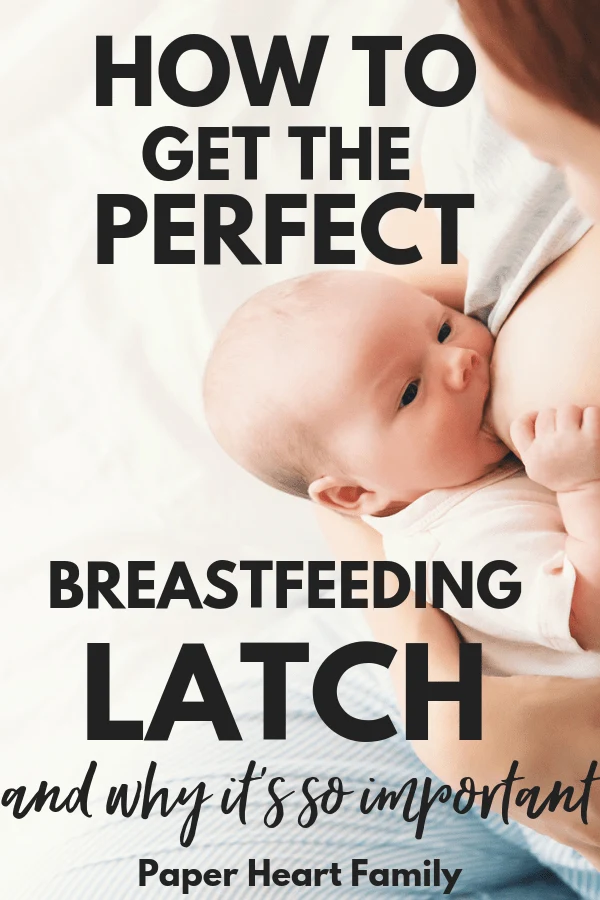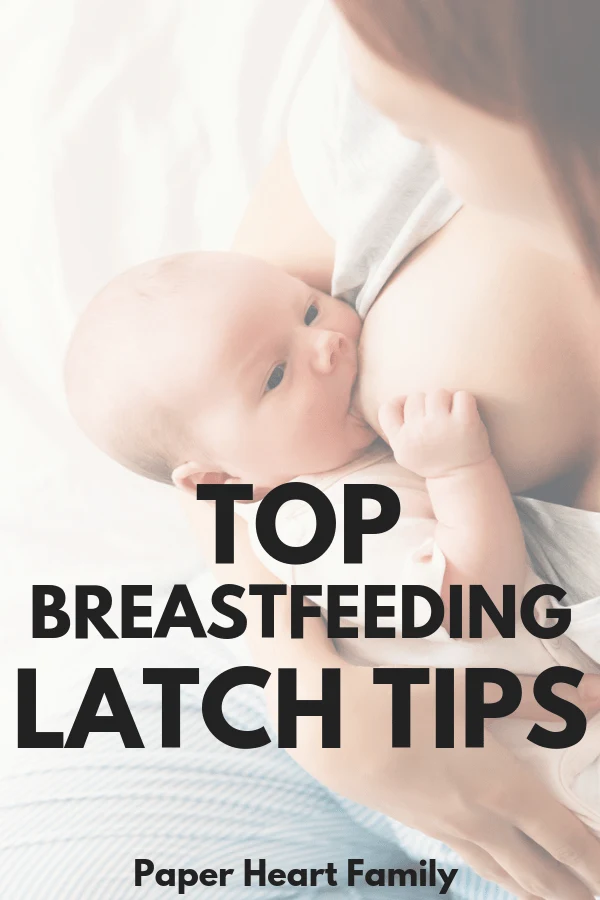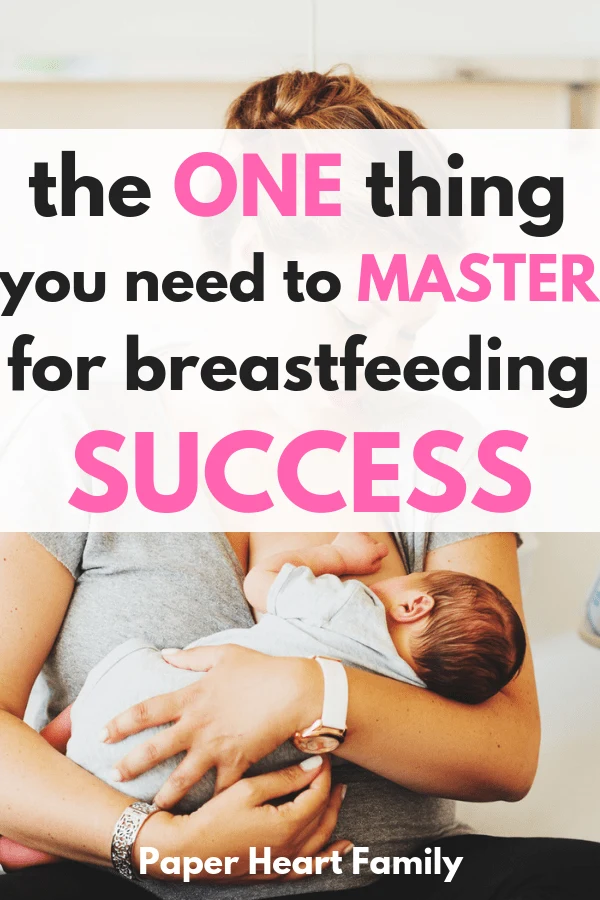Taking some time to ensure that your baby is latching on well is the number one most important thing that you can do as you are beginning your breastfeeding journey, but is also one of the top breastfeeding problems.
These breastfeeding latch tips will help you to get that perfect latch, and on your way to breastfeeding for as long as you and your baby would like.
A good latch equals maximum milk removal and minimal pain felt by mom.
Related: What to do when breastfeeding is painful
These latching tips will help you to avoid a lot of the most common breastfeeding problems like low milk supply, low baby weight gain, breastfeeding pain and sore nipples and more.
It all starts with a good latch.
My first baby latched beautifully from the very beginning. When she first latched in the hospital, it was natural. It was beautiful. I instantly fell in love with the act of breastfeeding. And I ROCKED at breastfeeding.
I thought that there must be something wrong with the moms who just didn’t get it right away.
What an amateur I was.
Related: Breastfeeding Tips New Moms Need To Read
Because then the second child came along and taught me that I really didn’t know anything about breastfeeding (or parenting in general, because man, that second child is the one that tests your beliefs on everything).
She struggled to latch.
Breastfeeding her was awkward. And painful. And UNNATURAL. And not at all the idyllic experience that I remembered and expected.
All your baby knows is that he’s hungry, and frustrated, and he was just unwillingly thrust (contracted?) into this bright, harsh, noisy, cold place, feeling a hunger that he has never felt before.
And he’s flailing, and pecking and SCREAMING.
This post contains affiliate links.
Luckily, I was patient and stayed calm (even though inside my mind I was feeling like a complete and utter failure). Okay, maybe I wasn’t so patient and calm, but thankfully I was determined.
Pretty quickly, her latch issues were fixed and we were able to happily continue breastfeeding for a very, *ahem* VERY long time.
Does latching get easier as baby grows?
I know you don’t believe it now, but there will be a time when breastfeeding is like second nature, and you literally have to do nothing in order for your baby to latch on.
For my daughter, it was the position of her tongue that wasn’t correct. However, there are many reasons that your baby might have a poor latch.
Breastfeeding Latch Tips

Breastfeeding Latch Problems
First, let’s talk about what might be going wrong.
- Your baby’s latch might be too shallow.
- Your baby’s tongue might not be in the right position.
- Your baby is having trouble latching due to engorgement.
- Your nipples are flat or inverted, therefore making it more difficult for your baby to latch.
- Your baby has a tongue-tie.
- Your baby is premature and therefore has a smaller mouth.
- You are experiencing a lot of pain, bleeding and/or cracked nipples. Make sure that you have a really good nipple cream and that you apply it after every SINGLE latch.
If your baby is clicking while breastfeeding, it could be an indicator that your latch is poor. Read more about clicking here.
Now let’s talk about how to solve these breastfeeding latch problems.
Proper Breastfeeding Position
Getting into the proper breastfeeding position is the first step.
First, make sure that YOU are comfortable. You shouldn’t be hunched over or tense.
Sit in a comfy chair, relax and use a nursing pillow in order to bring your baby up closer to you (especially necessary if you have smaller breasts).
Relax your shoulders and keep your body relaxed as your are latching your baby. Especially if your baby wants to stay latched all day.https://www.paperheartfamily.com/baby-wants-to-breastfeed-constantly/ If you’re body is tense for 30-45 minutes a day, 8+ times a day?!
Point made. Re-lax.
Next, use these tips to learn how to latch your baby.
Hold baby in your chosen breastfeeding position and bring your baby’s entire body toward your nipple. Do NOT move your breast toward your baby. Remember, that will cause you to be hunched over and uncomfortable.
Hold your baby’s back, NOT your baby’s head. If you are holding your baby’s head, your baby is not going to be able to latch well. Think about how you drink. You drink with your head tilted back, not with your chin tucked into your neck. Your baby’s position should be the same.
Wait for your baby to open wide.
If this doesn’t happen, you can encourage your baby to open wide by:
- Tickling your baby’s lips with your nipple
- Gently pulling down on your baby’s chin with your thumb
- Stroking your baby’s cheek
Bring your BABY in toward the breast quickly, do NOT move your nipple toward your baby.
Once your baby is latched, ensure that:
- your baby’s lips are flared out
- most of your areola is in your baby’s mouth
- your baby’s chin is touching your breast
- your baby’s ears are moving while nursing
- baby’s tongue is visible underneath his lower lip
- you can hear your baby swallowing. At first, your baby will begin with quick sucks (during letdown) followed by longer, slower sucking.
- you don’t hear a clicking sound
- upon unlatching, your nipple is not misshapen
Becoming familiar with (and using!) different breastfeeding positions is important as different positions can help empty the breast and help prevent clogged ducts and mastitis.
While you likely won’t feel comfortable using every possible breastfeeding position out there, try to find one or two that you and your baby like.
The best breastfeeding position is the one that works best for you!
This post will teach you about the 6 best breastfeeding positions: the cradle hold, the cross-cradle hold, the football hold, laid back breastfeeding, side-lying nursing and baby carrier breastfeeding.
How To Get Baby To Latch Deeper/How To Correct A Shallow Latch

One simple way to get your baby to latch deeper is by using the laid-back breastfeeding position.
In order to do this, lay back in a reclined position on a chair or in a bed. Using skin-to-skin, place your baby on your chest and allow your baby to self-attach.
Breastfeeding Latch Trick
If your baby is struggling still with a shallow latch, there is a latch technique called the flipple technique.
In order to latch using this technique:
- Bring baby close to you
- Using your thumb, pull your nipple up and away from your baby’s mouth
- Use your thumb to gently push your nipple into your baby’s mouth
See the flipple technique in action here:
How To Get Baby To Latch Wider
When your baby is opening his mouth in order to latch, you can gently press on his chin in order to encourage him to open wider. You can also do this once your baby is already latched.
Make sure that your baby’s chin touches your breast first, which encourages your baby to open wider.
You can also try different positions to see if your baby finds it easier to open wide from a different angle.
Breastfeeding Latch Video
If all of this is still difficult for you to comprehend because you need a visual, be sure to check out this video.
Using A Nipple Shield
If you are experiencing latching problems that are beyond what a different position or technique can fix, the use of a nipple shield temporarily could be helpful. Just make sure that you are using if for as little time as necessary, or else you might find yourself struggling to wean from it.
Reasons that you might need to use a nipple shield:
- Your baby’s tongue isn’t in the correct position
- Your baby is premature
- You have flat or inverted nipples
- If you are experiencing severe pain from an incorrect latch and your nipples need a break
In my daughter’s case, she didn’t have her tongue in the correct position. Using a nipple shield forced her tongue in the correct position, and after 3 days of use, she learned how to latch properly and I was able to take the shield away without any issues.
If your baby is premature or you have flat or inverted nipples, as your baby becomes older and stronger, you baby should have no difficulty latching correctly.
Getting the perfect latch is the foundation to a great breastfeeding experience, but there is so much more to it. So many new moms quit breastfeeding before they would really like to because of breastfeeding issues.
If you truly want to ensure breastfeeding success, you need to make sure that you have the knowledge and support to make it!
My friend Stacey, a certified lactation consultant, has an amazing online breastfeeding video course. This course covers everything, you can access the videos at any time (and from anywhere!) and it’s ridiculously inexpensive.
And good luck! It gets so much easier and enjoyable. The best is yet to come!


29 Best Ever Breastfeeding Tips For New Mothers
Sunday 16th of June 2024
[…] Encourage the perfect latch with these tips: […]
12 Reasons Your Baby Is Hungry After Breastfeeding
Monday 17th of July 2023
[…] that, it shouldn’t be such an owie toe-curling pain. If it is, then check out these latch tips because chances are, your baby has an improper […]
Timeline of a Breastfed Baby- What To Expect From Birth To Weaning
Tuesday 18th of April 2023
[…] 3. Make sure that your baby is latching perfectly. […]
How To Increase Milk Supply: Causes And Solutions
Sunday 9th of April 2023
[…] ✔️ Your baby has a poor latch. If your latch isn’t good, your baby isn’t going to remove milk sufficiently. Read my tips on how to get a good latch. […]
Birth Without An Epidural: Can You Do It?
Sunday 9th of April 2023
[…] Studies suggest that your baby might have trouble with the breastfeeding latch. […]